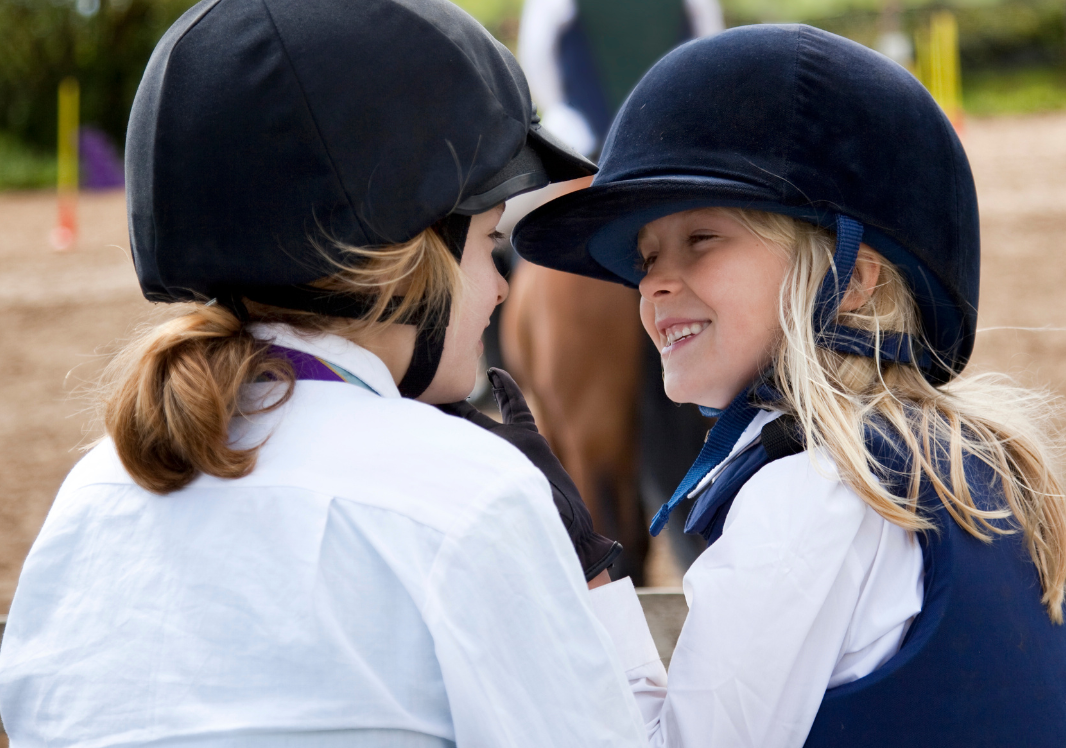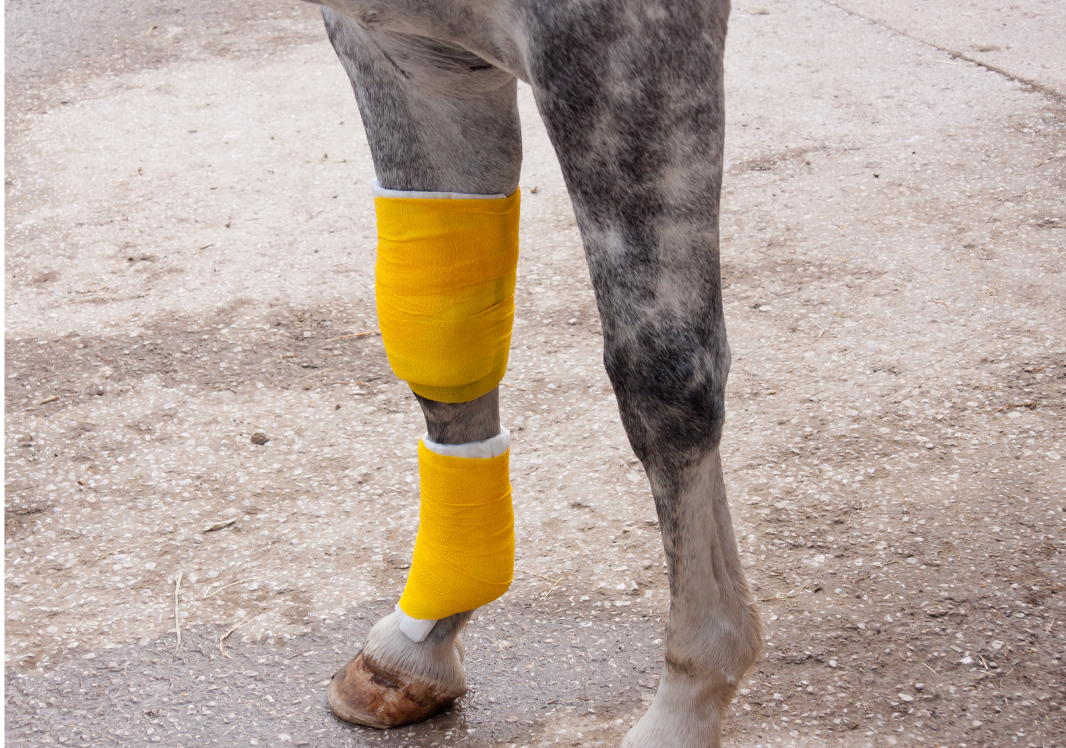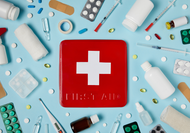Do you know the normal temperature of a horse, or how to read his pulse rate? Part of being a responsible horse owner is to be aware of basic equine first aid - from treating minor wounds to identifying serious problems and dealing with them while awaiting the vet.


Our Donald needed staples after accidently getting this nasty injury!
As we all know, horses are naturally accident prone! No matter how careful you are injuries and ailments are common.
You can't always prevent injury to your beloved horse, but you can be prepared for the eventuality, and educate yourself in basic first aid. Being ready to deal calmly and efficiently with an equine emergency can greatly increase the chances of a successful outcome.
First Line of Defence
Your first line of defence is a well-stocked First Aid Kit, kept handy in the tack room and taken with you wherever you travel with your horse. (At the end of this article is a list of essentials for your Horse First Aid Kit, which should be stored in a clean, dry box.)
Minimise risk by making sure your horse (and you!) are regularly vaccinated against Tetanus. Check your horse over for any signs of injury or discomfort every day, and treat minor cuts and grazes promptly to prevent them from becoming worse.
How to assess an Injury
Lacerations of the skin are the injuries you are most likely to use First Aid treatment for, in order to stem bleeding and prevent infection.
Assess the wound so you can decide if it requires professional attention.
If the wound is deep, bleeding profusely, and longer than a few centimeters you should call the vet.
Veterinary treatment is also essential if the horse is lame, shows signs of an internal injury or the wound impinges on a joint or the eyes. Unexplained lumps, inflamed and/or swollen areas should also be investigated by a vet.
Puncture wounds can be particularly dangerous because you may not be able to judge how deep they are, and there is a great risk of infection. These are best assessed by a vet, and if the foreign body that caused them is still in situ, don't be tempted to remove it yourself.
If the injury seems minor, and the horse is not showing any signs of distress or abnormal behaviour, you can treat him yourself.
Keep Calm and Confined
Before you start, or while you wait for the vet, you should keep the horse calm, confined in a safe, comfortable place, and work at stopping any bleeding.
If your horse has a large wound that will require stitching by the vet, apply a pressure bandage to slow down bleeding while you wait. A thick pad of gauze secured with adhesive tape is fine, or if you can't wrap it, hold the pad firmly in place, applying pressure.
It is wise to check your horse's pulse, respiration rate and temperature, either to assure yourself all is well or to assist the vet with the information.
There are many occasions on which it is useful to be able to check your horse's temperature, pulse and respiration. As a horse owner you should practise these procedures even when the horse is fit and well, so that you can conduct the checks easily and efficiently when the horse appears to be injured, in pain or suffering a fever.
Vital Signs
Firstly you need to know the normal range of vital signs for a horse, so that you can judge when something is amiss.
Temperature: 36.9C to 38.3C ( 98.5F to 101F)
Pulse: 28 to 45 beats a minute
Respiration: 8 to 20 breaths per minute
Remember if the weather is unduly hot, and when the horse has been exercising, the temperature will be raised. Likewise if the horse is stressed or excited the pulse and respiration rate will be higher.
Taking a horse's temperature should be done with care. Use a digital equine thermometer and keep it in place in the rectum for at least a minute. A horse's pulse can be felt in the facial artery under the lower jaw, with the flat of two fingers, or preferably a stethoscope. The respiration rate can be counted by standing a few feet away from your horse, side on, and watching his ribcage rising and falling (one rise and fall equals one breath).
Another good indicator of problems in the health of a horse are the gums, which should be a healthy pink. If they are pale it could indicate anemia, grey-blue indicates circulation problems and bright red could be a sign of fever and illness.
Treating Minor Injuries
To clean an open wound - cut or abrasion - use a sterile saline solution, or flush it thoroughly with water. You need to wash out any bacteria to prevent infection. The same applies to shallow puncture wounds, as long as the object which pierced the flesh is no longer inside. If you at any time feel the wound is too deep or difficult for you to deal with, or if it won't stop bleeding, rather leave it and call the vet.
In the case of a graze, make sure the damage is no more than skin deep, then gently clean it and apply a disinfectant solution. During healing - which could take days or even weeks - keep an eye out for swelling and any sign of discomfort in your horse. You can apply wound cream to help it heal and protect it from contamination.
Any jagged lacerations, those leaving a flap of skin, or injuries that might impact on joints, ligaments and tendons may need an antibiotic and pain relief, and are best left to a vet. In this case you will be given instructions about bandaging and aftercare, which you'd be wise to adhere to!
First Aid Kit Essentials - All available on our website.
Here are the essentials for an equine first aid kit ....
Clean hand towels
Bowl or small bucket
Rolls of gauze bandage and/or Gamgee tissue
Sterile saline solution
A syringe for wound flushing
Disinfectant
Roll of cotton wool
Wound gel/cream
Scissors
A purple spray
A selection of bandages
Tweezers
Thermometer
Petroleum jelly
Ready to use poultice
Hoof pick
Latex Gloves
We hope you rarely need to use your first aid knowledge or kit, but you can ride safe and happy if you are well prepared to meet adversity!



